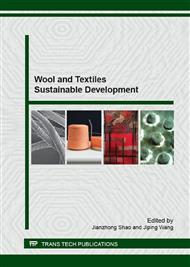[1]
2013 China Water Resources Official Journal. China's Ministry of Water Resources (2013). Information on http: /www. mwr. gov. cn/zwzc/hygb/szygb/qgszygb/201411/t20141120_582980. html.
Google Scholar
[2]
Information on http: /www. ccchina. gov. cn/Detail. aspx?newsId=46794&TId=65.
Google Scholar
[3]
Hoekstra, A.Y., et al., The Water Footprint Assessment Manual: Setting the GlobalStandard. Earthscan: London, (2011).
Google Scholar
[4]
British Standards Institution, UK. PAS 2050: 2011 Specification for the Assessment of the Life Cycle Greenhouse Gas Emissions of Goods and Services.
Google Scholar
[5]
Chapagain, A.K., et al., The water footprint of cotton consumption: An assessment of the impact of worldwide consumption of cotton products on the water resources in the cotton producing countries. Ecological economics, 2006. pp.186-203.
DOI: 10.1016/j.ecolecon.2005.11.027
Google Scholar
[6]
Yan, Y., et al., Study of the industrial water footprint of several typical cotton textiles in China. Acta Ecologic Sinca., 2014. 23. published online. http: /www. cnki. net/kcms/doi/10. 5846/stxb201303050349. html.
Google Scholar
[7]
Zhang, Y., et al., The industrial water footprint of zippers. Water Science and Technology, 2014. 70(6): pp.1025-1031.
Google Scholar
[8]
Bevilacqua, M., et al., A carbon footprint analysis in the textile supply chain. International Journal of Sustainable Engineering, 2010. pp.1-13.
Google Scholar
[9]
Zhao, N.H., Carbon footprint assessment and low carbon measures of thepolyester textile. Donghua University master thesis, (2012).
Google Scholar
[10]
Soode, E., et al., Carbonfootprints of the horticultural products strawberries, asparagus, roses and orchids in Germany. Journal of cleaner production, 2015. 12: pp.168-179.
DOI: 10.1016/j.jclepro.2014.09.035
Google Scholar
[11]
Chen, L.Z., et al., Modular Calculation Method of Carbon Footprint and Water Footprint of Textile and Clothing Products. Proceeding of the 5th Cross-straits Conference on Textiles, Hong Kong, 2014. 17-19: pp.107-112.
Google Scholar
[12]
Li, X., et al., The emission factor of commonly used energy for textiles and apparel product carbon footprint accounting. Shanghai Textile Science & Technology, 2014. 42(1): pp.55-58.
Google Scholar
[13]
Zhang, Y., et al. Water footprint factor of energy and materials in textile and garment industry. Dyeing and Finishing, 2013. 18: pp.41-45.
Google Scholar


